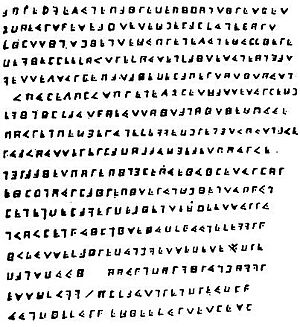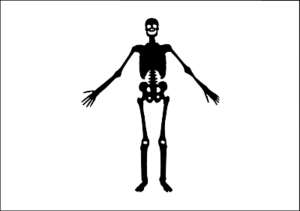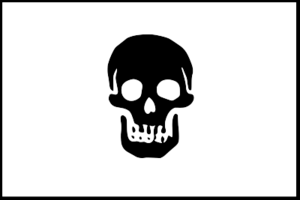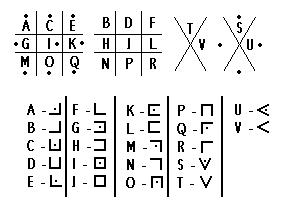Olivier Levasseur facts for kids

Olivier Levasseur (born between 1688 and 1690 – died 7 July 1730) was a French pirate. People called him La Buse ("The Buzzard") or La Bouche ("The Mouth"). He got these nicknames because he attacked his enemies very quickly and fiercely. He was also good at arguing with people.
Levasseur is famous for supposedly hiding one of the biggest treasures in pirate history. Some people think it's worth over $1 billion! He is said to have left a secret message, called a cryptogram, with clues to find it. He also inspired the character Gol. D. Roger, the king of pirates, in the popular manga series, One Piece.
Contents
Biography of a Pirate
Olivier Levasseur was born in Calais, France, during a war called the Nine Years' War (1688–1697). His family was wealthy, and he received a great education. He even became an architect.
During another war, the War of the Spanish Succession (1701–1714), King Louis XIV gave him a special paper called a letter of marque. This paper allowed Levasseur to become a privateer. Privateers were like legal pirates who attacked enemy ships for their country.
When the war ended, Levasseur was supposed to go home. But he decided to become a pirate instead! In 1716, he joined a pirate group led by Benjamin Hornigold. Even though one of his eyes had a scar and he couldn't see well, Levasseur was a good leader and shipmate.
After a year of successful raids, Hornigold's group split up. Levasseur briefly worked with Samuel Bellamy. Then, he decided to try his luck on the coast of Brazil. He sailed on a stolen ship called La Louise, which had 22 cannons.
On his way to Brazil, he attacked many boats and ships. He once robbed a ship carrying people from Angola. After taking what he wanted, he left the damaged ship and its crew behind. He later left 240 people on an island near Macae in Brazil.
Portuguese armed boats chased him. After some fights where ten pirates died, La Louise hid in Cananeia. Levasseur learned about a rich French merchant ship nearby. While chasing it, La Louise got caught in a storm and sank on March 9, 1718. About 80 of his crew died. Levasseur escaped on a smaller boat and sailed south. He robbed a boat with cassava flour to feed his remaining crew.
The pirates then sailed north again, looking for more ships to attack. Levasseur later appeared in the Caribbean in a smaller vessel he had stolen. He almost got caught by a British warship, HMS Scarborough. He escaped with his valuables and joined his old pirate friends.
In 1718, Levasseur became captain after the crew of William Moody chose him. In 1719, he worked with other pirates like Howell Davis and Thomas Cocklyn. In 1720, they attacked a port called Ouidah in what is now Benin. They destroyed the local fort. Later that year, his ship was wrecked, and he ended up on Anjouan island. By this time, his bad eye was completely blind, so he started wearing an eyepatch.
From 1720 onwards, Levasseur launched his attacks from Sainte-Marie island, near Madagascar. He worked with other pirates like John Taylor and Edward England. Rich pilgrim ships from the Great Mughal empire, heading to Mecca, sailed in these waters. These ships were heavily armed but also full of treasure.
Levasseur's second-in-command was Paulsgrave Williams. They first robbed the Laccadives islands and sold the stolen goods to Dutch traders for $75,000. Levasseur and Taylor eventually got tired of England's kindness and left him on the island of Mauritius.
The Greatest Treasure Capture
Levasseur and Taylor then pulled off one of the biggest pirate raids ever. They captured a huge Portuguese ship called Nossa Senhora do Cabo (Our Lady of the Cape). This ship was packed with treasures belonging to the Bishop of Goa and the Viceroy of Portugal. Both important people were on board, returning home to Lisbon.
The pirates were able to board the ship without firing a single shot! This was because the Cabo had been damaged in a storm. To stop it from sinking, the crew had thrown all 72 of its cannons overboard. The ship then anchored near Réunion island to be fixed.
The treasure was amazing! It included gold and silver bars, many boxes full of gold coins called Guineas, diamonds, pearls, silk, art, and religious items from a cathedral in Goa. One item was the Fiery Cross of Goa, made of pure gold and covered with diamonds, rubies, and emeralds. It was so heavy that three men were needed to carry it to Levasseur's ship. There was so much treasure that the pirates didn't even bother to rob the passengers, which they usually did.
When the loot was shared, each pirate received at least $50,000 worth of gold Guineas and 42 diamonds. Levasseur and Taylor split the rest of the gold, silver, and other items. Levasseur took the golden cross.
Capture and Execution
In 1724, Levasseur sent someone to talk to the governor on Bourbon island (now Réunion). He wanted to discuss an amnesty, which was a pardon offered to pirates in the Indian Ocean if they stopped their pirating. However, the French government wanted a large part of the stolen treasure back. So, Levasseur decided not to take the amnesty. He secretly settled down in the Seychelles islands.
Eventually, he was caught near Fort Dauphin, Madagascar. He was then taken to Saint-Denis, Réunion, and executed for piracy at 5 PM on July 7, 1730.
The Hidden Treasure

The Cryptogram's Discovery
At the start of the 1900s, a famous French historian named Charles de La Roncière said he helped study a secret message. He believed it was from the 1700s.
This secret message, or cryptogram, belonged to a young woman from the Seychelles. She had asked for a book called the Clavicles of Solomon. Even though they couldn't fully solve the message, it started a huge treasure hunt that is still going on today! People think the Buzzard's treasure might be in Réunion, the Seychelles, Rodrigues, Madagascar, Mayotte, or Sainte-Marie Island.
Legend says that when Levasseur was about to be executed, he wore a necklace with a 17-line cryptogram. He threw it into the crowd and shouted, "Find my treasure, the one who may understand it!" The necklace is now lost, but treasure hunters have been trying to decode the cryptogram ever since. They hope it will lead them to the treasure.
Treasure Hunters and Their Search
On Réunion Island, a French treasure hunter named Joseph Tipveau, also called Bibique, spent much of his life looking for the treasure.
On Rodrigues island, the grandfather of a famous French writer, J. M. G. Le Clézio, settled down and dug in a gully for twenty years.
In 1947, an Englishman named Reginald Cruise-Wilkins studied the documents. He found the cryptogram was harder to solve than he thought. Cruise-Wilkins believed the code might be based on Masonic symbolism. He claimed it was connected to the Zodiac, the Clavicles of Solomon, and the Twelve Labours of Hercules. He thought certain tasks, like Hercules's labors, had to be done in a specific order. He believed the treasure room was underground and needed careful entry to avoid flooding. It was protected by tides, needing dams to hold them back, and should be approached from the north.
Until he died in 1977, Cruise-Wilkins searched and dug on Mahé island. He found old guns, coins, and pirate coffins in a cave, but no treasure. His son, John Cruise-Wilkins, a history teacher, is still looking for the treasure. He believes he needs to "get into this guy's mind" to find it.
More recently, a young French researcher named Emmanuel Mezino claims to have solved the cryptogram. He believes he has found the exact location of the treasure on Réunion Island. He says he joined a team in 2012 and cracked the code. He wrote about his discovery in his 2014 book, ‘Mon trésor à qui saura le prendre’. He says it's hard to dig there because they haven't gotten permission. He also worries that parts of the site are being dug up illegally, and some items have already disappeared. He believes the treasure should be in a museum.
In November 2023, a French chemist named Cyrille Lougnon published a book about Olivier Levasseur. He said he found a large stone structure on Réunion Island, less than 1,000 meters from a road. He believes the treasure might be hidden under this structure.
Is the Cryptogram Real?
The secret message was first mentioned in a 1934 book. However, old records from Levasseur's time don't mention his cryptogram, his necklace, or his speech at the gallows. Many modern historians who study pirates think this legend is a story made up in the 1900s.
See also
 In Spanish: Olivier Levasseur para niños
In Spanish: Olivier Levasseur para niños




